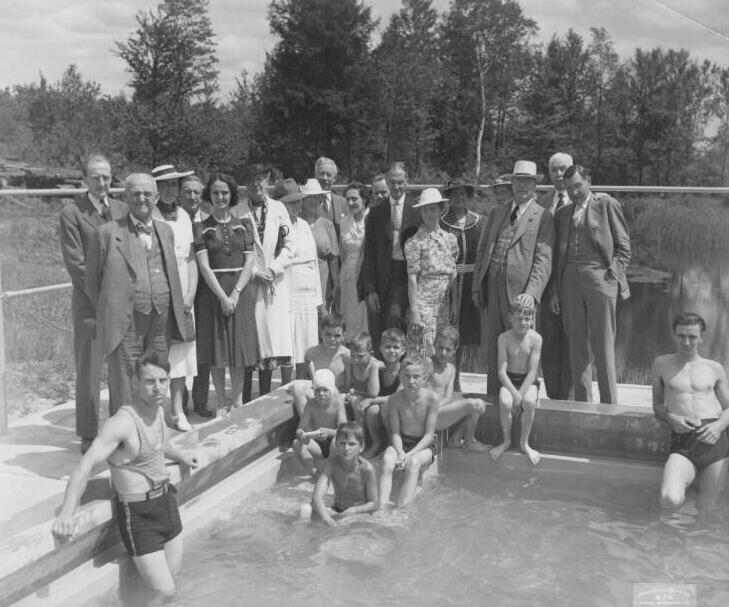
Figure 1.--Here we see a WPA project in 1939. WPA financed a therapy pool in Baldwinville, Maryland. The builders and WPA officials stand at the back for the pool's opening. And we see some of the adults and children enjoying the pool. |

|
An important part of the First Hundred Days was expanding relief (money and food) programs to the unemployed and other afflicted groups. Relief was, however, a stop gap measure to allow Americans to survive the Depression until jobs once more became available. The Depression persisted. Here economists differ on why this was. Some might say that business had not adjusted to hiher taxes and an expanded Federal regulatory role. Others might say that the Administration did not adequately apealed to business. There are also questions of fiscal and monetary policy. While economists debate these questions, it is clear that the private sector did not recreate the jobs that had been lost. The Roosevelt Administration's answer was a flurry of New Deal legislation in 1935. This was in part possible because of the Democratic Congressional victories in the 1934 by-election. The new programs included the Works Projects Administration (WPA) which provided jobs not only for laborers but also artists, writers, musicians, and authors. The WPA became in large measure the public face of the New Deal. Another critical piece of New Deal legislation was the Social Security Act which provided unemployment compensation and a program of old-age and survivors' benefits. The WPA and Social Security became the centerpieces of the New Deal. The WPA did not survive as a permanent agency. Social Security of course did.
An important part of the First Hundred Days was expanding relief (money and food) programs to the unemployed and other afflicted groups. The new president undertook immediate actions to address the most pressing priblems and rally the nation. The idea was to restore confidence and jump-start a faltering economy with emergency action. To halt depositor panics, he closed the banks temporarily. Then he worked with a special session of Congress during the first "100 days" to pass recovery legislation. It was the most productive 100 days in Congressionl history. The Congress was willing to follow the President's lead as few times in history. The result was the alphabet agencies, some of which continue to play major roles in American life. The Agricultural Adjustment Administration (AAA) was created to support farm prices. The (Civilian Conservation Corps (CCC) employed young men. The Federal Emergency Relief Administration (FERA) was created to deal with the the emergency needs of those most severely affected by the Repression. The Home Owners Loan Corp. was created to help avoid evictions and make new home mortgages possible. The Public Works Administraion (PWA) was established to create jobs for needed public construction projects. The Securities and Exchange Commission (SEC) was created to regulate the stock market. Wall Street strenuously resisted the bill creating the SEC. The fight was led by the imperious President of the New York Stock Exchange, Richard Whitney. A few years later, Whitney was arresed when his investment company collapsed. He was found to have been looting the accounts of clients and convocted of embezzlement, receiving a prison sentence. Other New Deal agencies were created to assist business and labor, insure bank deposits, subsidize home and farm mortgage payments, and assist the unemployed.
Relief was, however, a stop gap measure to allow Americans to survive the Depression until jobs once more became available. The Depression persisted. Here economists differ on why this was. Some might say that business had not adjusted to hiher taxes and an expanded Federal regulatory role. Others might say that the Administration did not adequately apealed to business. There are also questions of fiscal and monetary policy. While economists debate these questions, it is clear that the private sector did not recreate the jobs that had been lost. This is an important question that needs to be considered in some detail. Most other countries by 1835 had either emerged from the Depression or beginning to return to more normal economic conditions. The question needs to be asked as to why this did not occur in America.
The American people gave the new President high marks for actuin to deal with the Depression. Expanded relief programs managed to help meet the basic needs of the destitute. This positive assessment led to more Democratic victories throughout the country, This significantly widened the Depocratic majorities in both houses. This meant that the Republican minority was further reduced and unable to effectively resist Administration proposals. With larger majorities in both houses of Democrats willing to support the Presodent's lead, the United States embarked on furthur social legislation that would not have been considered before the Depression. Only if the Republicans could attract support from conservative Southern legislators could any effective resistance be mounted. But even this was difficult given rge President's great popularity in the South.
The Roosevelt Administration's answer to the persistance of the Depression was a flurry of New Deal legislation in 1935. The new programs included the Works Projects Administration (WPA) which provided jobs not only for laborers but also artists, writers, musicians, and authors. The WPA became in large measure the public face of the New Deal. Another critical piece of New Deal legislation was the Social Security Act which provided unemployment compensation and a program of old-age and survivors' benefits. The WPA and Social Security became the centerpieces of the New Deal. The WPA did not survive as a permanent agency. Social Security of course did.
Navigate the Boys' Historical Clothing Web Site:
[Return to Main New Deal page]
[Introduction]
[Activities]
[Biographies]
[Chronology]
[Clothing styles]
[Countries]
[Bibliographies]
[Contributions]
[FAQs]
[Glossaries]
[Images]
[Links]
[Registration]
[Tools]
[Boys' Clothing Home]
